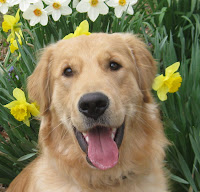
Griffin is a retriever, but not crazy about retrieving. He does love to swim. And he's starting to learn to love tugging.
Most mornings this summer, we go out to the pond and do some retrieves for play/fun/exercise. Very quickly I realized that Griffin was really starting to love the water retrieves. If not working, he would run to the edge of the pond and stand there, staring out, impatiently waiting for the toy to hit the water. He did not want to come away from the water.
Despite being the most adorable dog, he's not 100% reliable with everything. There have been occasions where I ask him to do something and he says, "No....NOT now." But when I call him away from the water, he was not politely refusing to come, he was completely non-responsive.
In most contexts in life, Griffin knows to work to get the things he wants. He will back away from my plate in hopes of getting a crumb. He will hold his stay, hoping for a release. He will heel past smells on the ground, hoping to be released. He will not look at distractions nearby, hoping to be allowed to explore. If he wants something, whether material or information, he will turn to me with various levels of intensity. But with the pond, he just stood there, staring.
This was a good thing in one very important way: Water retrieves are a high value reinforcer. Probably THE highest value reinforcer we currently have available. That meant, I had something that was not previously available. He's never been super crazy about any types of food (raw meat, cooked meat, tripe, bread) or toys (furry or fuzzy, retrieving or tugging or throwing or squeaking....). The lack of high value reinforcers has really made training difficult.
Our training plan: Transfer our love of water retrieves to other things.
So, just like working with the secondary reinforcer lesson the kids had on Friday.... for a few weeks we did various combinations.
- Tug on frisbee, verbal marker, toss another into pond. Thus his love of tugging grows to almost the level of water retrieves.
- Tug on frisbee, ask for a release when he is tugging well. Mark the release, throw the toy into the pond. His love of releasing the toy grows.
- Short retrieve on land. He brings it back and I toss that toy or another into the water. His love of retrieving on land grows.
- Ask for a return/sit at heel. I throw a toy in the pond. His love of returning to heel grows.
- Ask for a short stay, release, mark, toss toy. His love of stay releases grows.
- Ask for a stay, toss in toy (initially, just to the edge), release when he is still. His love of staying grows.
And as a result? He's now able to work much better around the water. On occasion he still is racing to the edge to gaze out hopefully before returning to me and asking to work. And sometimes on his stays, he is next to me, quivering, but his feet are all in place.
 |
| Blaze Swims Too! |
We still have a ways to go, but having that high value is SO helpful. As I'm sure I've said before.... having high value reinforcer/s is often THE thing that determines student success. Dog breed/age/gender/history.... not too relevant. Trainer experience/skill/relationship ...definitely impacts things. Practicing always helps. But, if there are high value reinforcers available? We can teach the dog how to appropriately access these things....and training goes very well.




















